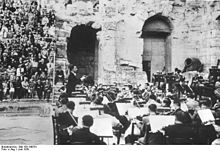Odeon of Herodes Atticus
The Odeon of Herodes Atticus ( Greek Ωδείο Ηρώδου του Αττικού or Ηρώδειο) is an ancient theater at the foot of the Acropolis rock in Athens . The theater was donated by Herodes Atticus and holds 5000 spectators. It has been used regularly for events again since the 1930s and is the main venue for the Athens Festival.
history
After the Odeon des Pericles and the Odeon des Pausanias, it was the third building to be named Odeon in Athens. Herodes Atticus donated the theater to his hometown in AD 161 and dedicated it to the memory of his wife Regilla. From then on, the design of the odeon (Latin odeum ) spread beyond Athens, for example in Rome. The writer Pausanias mentioned the Odeon a few years after it was built in his description of Greece . The Germanic tribe of the Heruli sacked the theater in the year 267, and also destroyed the roof, which was never rebuilt. Extensive excavations took place in the 19th century. Even before the Odeon of Catania (in Sicily) it is the oldest extant ancient Odeon ever.
In modern times, the Odeon was the most popular venue for a long time, despite other comparable theaters (such as the Theater on the Lykavittos ). Here among others were Maria Callas and Mikis Theodorakis on. Nana Mouskouri gave her first concert here after 20 years in exile, Yanni recorded his album Yanni Live at the Acropolis here . In the meantime, the theater has given up its role as the most important stage to the acoustically better “Hall of Music Friends” in Megaro Mousikis , but it is still preferred in summer, especially since it is structurally open.
Building
In contrast to the larger neighboring Dionysus Theater, which has been preserved as a ruin , the Odeon is a theater based on Roman and not Greek design: the orchestra (playing area) is enclosed on the one hand by the auditorium and on the other hand by the stage. This consisted of a central building and two side wings. It is richly structured by numerous arched niches, the walls were clad with marble and provided with numerous statues. The auditorium was covered by the largest known roof structure of antiquity, which reached a clear width of almost 50 m. The 32 steeply rising marble rows of seats form a semicircle and hold 5000 spectators. 1952–1953 the auditorium was restored to facilitate the theater operations.
Web links
Remarks
- ↑ Pausanias 7, 20, 6.
- ↑ Manolis Korres : The roofing of the theater or Odeion of Herodes Atticus in Athens. In: Alexander von Kienlin (Hrsg.): Wooden structures of antiquity. Istanbul 2011, pp. 273-286.
Coordinates: 37 ° 58 '15 " N , 23 ° 43' 28.3" E


